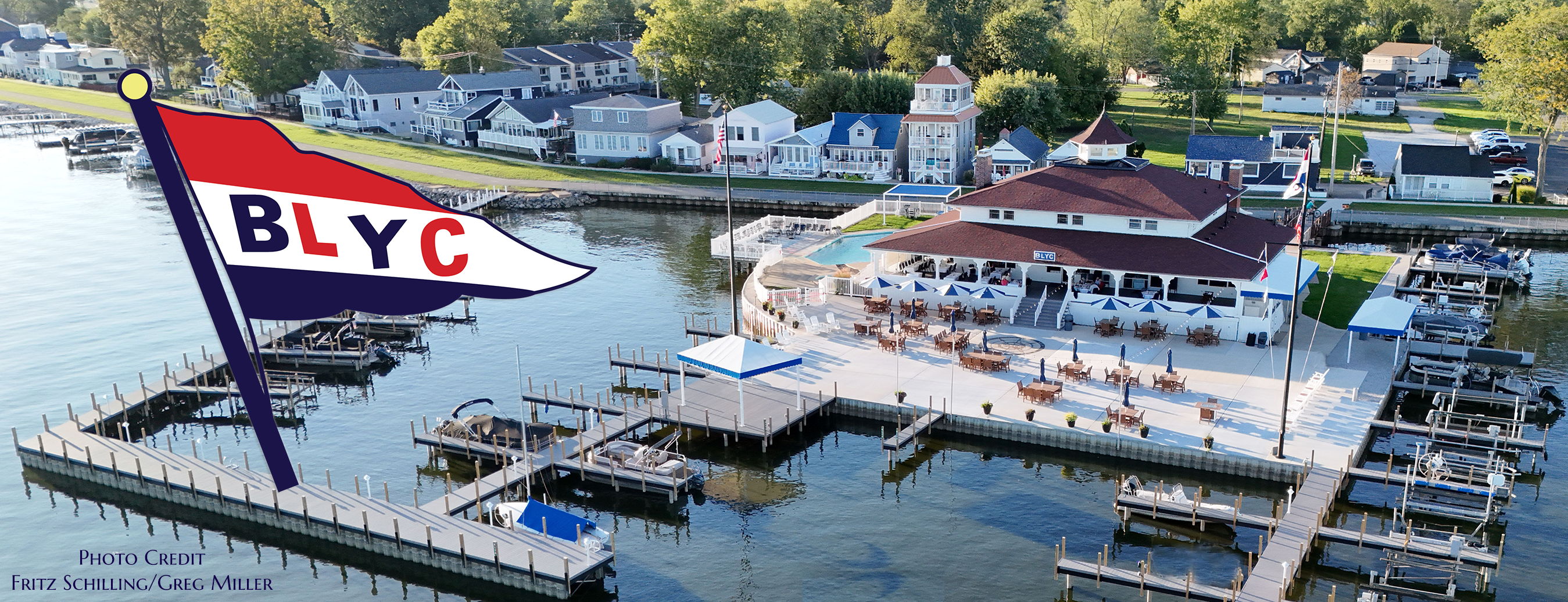Do have a sailing story, news, or helpful sailing-related information to share?
Please contact P/C Steve Harris to have it included. We’d love to hear from you.
– Steve Harris, NRO The Rolex Sydney Hobart Yacht Race is an annual event hosted by the Cruising Yacht Club of Australia, starting in Sydney, New South Wales, on Boxing Day and finishing in Hobart, Tasmania. The race distance is approximately 630 nautical miles (1,170 km). The race is run in conjunction with the Royal Yacht Club of Tasmania, and is widely considered to be one of the most difficult yacht races in the world. (from Wikipedia) As usual, the sailing world was following the progress of the annual event online as Ichi Ban, Celestial, and Quest were in a neck and neck race for line honors in the final hours. Quest eventually dropped back, leaving a neck-and-next race to the finish between the remaining two – after 4+ days of racing. This year’s race was particularly difficult. The sea conditions were very rough and over 1/3 of the fleet had dropped by the end of the first 24 hours. Ever since the disaster in the 1979 Fastnet Race, in which 75 boats capsized, 5 sunk, and 15 sailors lost their lives, there has been an ever increasing focus on safety in sailing – especially for offshore racing. The Sydney-Hobart is no exception. Locally, most of us are familiar with the safety equipment that ODNR requires us to have on board. However, for “big water” races, most often the US Safety Equipment Requirements are also invoked, requiring further specialized equipment and training. At the level of the Sydney-Hobart, there are similar requirements, and these are rather extensive. One such requirement that is actually also common at all levels, including inland racing, is the requirement to carry and monitor a VHF radio for emergencies. While not too long ago considered by many to be “unfair” communications, now it is common for Notices of Race and Sailing Instructions to include an instruction requiring boats to both carry and monitor radio communications at all times. Often, these instructions also include a requirement for checking in with the race committee and notifying them of a boat retiring. This very type of instruction has made for an interesting, although somewhat controversial end to this year’s Sydney-Hobart… From Sailing Scuttlebutt (12/29)… At the top of the standings today as of 4:30am AET is the TP52 Celestial owned by Sam Haynes, with Matt Allen’s Botin 52 corrected next by three minutes. But a protest by Allen against Haynes, along with a Race Committee protest against Haynes, may trump what occurred on the course… Both protests refer to Rolex Sydney Hobart Yacht Race Sailing Instructions 31.4 which states: ‘All boats shall maintain a continuous listening watch on VHF Channel 16 for the duration of their race. The protests were heard together by an International Jury on December 30 and the committee found against Celestial, penalizing her 40 minutes on elapsed time and, thus, giving the win to Ichi Ban. The facts found by the Jury were as follows: So, what does all this mean? Essentially, Celestial, while likely not purposely, violated the sailing instruction requiring them to “maintain a continuous listening watch” on the radio. While the penalty they received cost them the win, it could have been worse. Some commenting online think that the penalty they received, however, was still too harsh. Was it? In all reality, they could have been disqualified… While it may seem harsh to some, safety regulations such as this one exist for a reason. Safety cannot be secondary to winning. Sure, it would be a hard pill to swallow to lose a well fought race in the protest room for what is little more than an “accident.” That said, in my opinion, its better to have such regulations – and to have them strictly enforced – than to have someone lose their life on the water. (Read the full article about the protest from Sailing Scuttlebutt here) As of today – December 31 – Celestial has filed a Request to Reopen the hearing. Perhaps they have new information and evidence available. Perhaps they’re just “grasping at straws” and holding out hope that another panel may see it differently. I personally doubt that will be the case. Either way, the saga continues… Often, we focus our rules discussions only on Part 2 of the rules – “When Boats Meet.” This winter, I plan to explore the rules of Part 3 – “Conduct of a Race.” They may appear to only matter to the Race Committee, but they have significant importance to the racing sailor too. – Steve Harris, US Sailing National Race Officer This is more of a “grab bag” of other rules in Part 3. Each of their own importance, but not necessarily long enough for their own post. They have consequences for racing sailors but, generally, don’t require a long discussion. Simply put, these are directives to the race committee. These are both things that they must do, and items that they can do. This part of the rule contains a number of points… This rule simply prescribes a time by which the starting marks must be in place. Obviously, boats cannot start, or set up their start, without knowing the location of the line. Why the Preparatory Signal (4 min. pre-start)? I’m not sure there’s a great answer other than perhaps this…. Especially in varying wind conditions, the RC needs the capability to quickly set the line and go immediately into sequence to get a fair start off. By making this time at the preparatory signal, they can do so and reliably know that the mark will have settled into place in its final location by the required time. This part of the rule is permissive. I’m sure that at some time in the past there were redress requests that led to this being put into the rulebook , but basically, it makes it clear that the RC has the ability to call off a race, for any reason, before the start. After the start, they can no longer postpone and they can only abandon for reasons allowed under rule 32. This rule is, for the most part, pretty straightforward. IF the mark is part of the leg on which you are sailing, don’t touch it. This would also include start and finish marks. That’s where it gets kinda hairy… Before we get into that, however, what does it mean to “touch” a “mark?” This definition may seem a bit lengthy for what we might typically think the definition should be. In particular, what does “an object intentionally attached to the object or vessel” refer to? Often, race committees will stream a mark off the stern of the committee boat at one end of the start line. This is often called a “limit mark” or “keep away mark.” The intent is to keep boats starting from getting too close to the committee boat and potentially colliding with it. Since such marks are intentionally attached, to the vessel, they are, by rule, part of the mark and you cannot touch it. But what constitutes “touching” the mark? In several World Sailing cases, it has been established that “contact with a mark by a boat’s equipment constitutes touching it.” This would include contact by any part of the hull, crew, or equipment – essentially, any contact is contact. The one exception is that the anchor line is not part of the mark. So, for example, your rudder catches the anchor line as you round the windward mark. In reality, we all know that it is then likely that the mark would be pulled over and touch the hull, therefore being contact with the mark. However, if you were able to clear that line before the mark was pulled over and contacted the hull, you would not have violated the rule. NOW… finishing creates a unique circumstance. Although the definition of mark is the same throughout the race, two more definitions come into play at the finish – finish and racing… If you recall Post #5 in this series – Rule 28; Sailing the Course – I mentioned this situation and that it would require a longer discussion… Hitting a finish mark presents a unique situation. If we look at the definition of finish, we see that a boat finishes when any part of her hull crosses the finish line from the course side. However, looking at the definition of racing, she has to “clear the finishing line and marks” before she can be considered as no longer racing. In other words, until she has cleared the finishing line and marks, she is still subject to the rules, including Rule 31. Consider the following situation… In the diagram above, Boat B has met the definition of finish in that her hull crossed the line from the course side of the line. However, after crossing, she made contact with the finish mark. Since she clearly has not “cleared the finishing line and marks,” she is still racing, is subject to, and has violated Rule 31. What would the race committee do in this situation? What should the competitor do? At this point, she has met her obligation of making a one-turn penalty and no longer subject to protest. By doing so, she also has met the definition of finish. The RC will record this finish as well. As common practice, when a boat crosses the finishing line multiple times from the course side, good race committees will assign the lower of the scores. If the reason for multiple “finishes” is as described above, they have done it correctly. If there is some other reason, the competitor is sure to submit a scoring inquiry after scores are posted and it can be sorted out then. Often, we focus our rules discussions only on Part 2 of the rules – “When Boats Meet.” This winter, I plan to explore the rules of Part 3 – “Conduct of a Race.” They may appear to only matter to the Race Committee, but they have significant importance to the racing sailor too. – Steve Harris, US Sailing National Race Officer This is another “grab bag” of other rules in Part 3. Each of their own importance, but not necessarily long enough for their own post. They have consequences for racing sailors but, generally, don’t require a long discussion. If a mark is missing or out of position while boats are racing, the race committee shall, if possible, Placeholder If one boat starts, sails the course and finishes within the time limit for that race, if any, all boats that finish shall be scored according to their finishing places unless the race is abandoned. If no boat finishes within the race time limit, the race committee shall abandon the race. Often, we focus our rules discussions only on Part 2 of the rules – “When Boats Meet.” This winter, I plan to explore the rules of Part 3 – “Conduct of a Race.” They may appear to only matter to the Race Committee, but they have significant importance to the racing sailor too. – Steve Harris, US Sailing National Race Officer If the direction of the leg will be changed, the signal shall be the display of flag C with repetitive sounds and one or both of the new compass bearing or a green triangle for a change to starboard or a red rectangle for a change to port. If the length of the leg will be changed, the signal shall be the display of flag C with repetitive sounds and a ‘–’ if the length will be decreased or a ‘+’ if it will be increased. Subsequent legs may be changed without further signalling to maintain the course shape.” Although a bit lengthy, this rule is actually pretty straightforward. To ensure that we’re all using the same language, recall the post on RRS 32 about Shortening the Course… Shortening the course is the elimination of legs of the course. This is part of RRS 32. What this rule (RRS 33) speaks to is Changing the course. This sometimes creates confusion, as we discussed in Post #7. But, if you remember “C is for Change,” you’ll be fine with this rule. Keep in mind, the racing rules are written in such a way as to give the race committee tools that allow them to save a race. Lots of things happen on a race course that have the potential to make it less than ideal… Rule 33 makes it possible for the race committee to adjust to these changes and keep the racing fair, safe, and competitive. In the case of a wind shift, the course becomes less square and inherently less fair. Often, you’ll hear the argument “We’ve all got to sail in the same wind” as a reason not to move a mark and change it’s location. The problem is, not all boats in the fleet are truly in the same wind when the course isn’t square! Depending where you are on the course when the shift happens, some boats will be benefitted by a lift and others will be hampered by a header… and perhaps significantly so. Additionally, the tactically sailable area is also significantly reduced. In order to maintain the best tacking angle upwind, the area in which boats can tactically sail in is significantly reduced. 0° 50% 100% 0° 50% 100% The effective sailing area reduces much quicker with less of a shift! If the race committee doesn’t change the course, it’s hard to call it a fair, tactical, and competitive race. Changes are critical to making races competitive! The difficulty for the race committee is knowing when to make a change. It’s easy to get drawn into trying too hard to make it “perfect,” and changing when a shift is just an oscillation. But its important to change when necessary. Now you know why sometimes race officers are so uptight & tense! LOL The important part to be able to recognize is the display of the flag, C, with repetitive sounds. Direction of the change is likely apparent, however the race committee is required to signal it. Generally, the change will be signaled by a mark boat, near the mark previous to the one being changed. Unlike the shorten course signal (RRS 32), a change must be signaled before any boat sails the new leg of the course. The race committee has two options: … or a change to port (left as one looks towards the next mark) with a red rectangle The race committee can also change the length of the next leg… b. If the length of the leg will be changed, the signal shall be the display of flag C with repetitive sounds and a ‘–’ if the length will be decreased or a ‘+’ if it will be increased. So the race committee can change both the direction and the distance of the next leg of the course. Pay close attention to the signals being made. This affords them a great deal of flexibility in maintaining a competitive race course for the sailors. This course, Course “E,” is a typical triangle-windward-leeward course – Assume a significant windshift to the left makes it desirable to change the position of Mark 1 on the second windward leg. The race committee will signal the change at mark 3 (before any boat begins the leg). They will hoist Code Flag “Charlie” with repetitive sounds and a red rectangle. NOTE: The new mark need not be in the water yet. The signal tells you that a change is being made. By the rules, the mark doesn’t need to be there until boats are there to round it. Ideally, the race committee gets it into position well before any boat is approaching, but the rules give them a lot of leeway in making the change. Remember – the purpose is to “save” the race and keep it competitive. You would now sail to the “new” mark – ideally it is of a different color and/or shape (this would be described in the SIs), although that is not always the case. Notice that, to maintain the same course angles, the race committee should also move Mark 3 and change the angle of the finish line. Sometimes with short course racing, this isn’t always practical if the fleet is spread out, but, ideally, that would be the proper thing to do. Notice, however, that this subsequent “change” is not signaled… c. Subsequent legs may be changed without further signalling to maintain the course shape.” Once the first change is signaled, subsequent changes do not have to be signaled. In other words, you should assume that subsequent legs are likely to be changed. The race committee is free to do so without tying up valuable resources signaling at each mark. If a separate “change mark” is being used for the primary change, it is entirely possible that subsequent “changes” will not utilize these change marks. More than likely, the existing marks will be relocated to their adjusted positions if possible. “Change Marks” are not addressed specifically in the rules and there is not one standard practice used in this situation. Ok, not the best answer, but an accurate one. In some venues, the wind blows steady and at pretty much the same velocity and direction at the same time every day. Buckeye Lake is NOT one of those venues! In those places, particularly for “high level” events, a change of 10-15 degrees might be enough for the race committee to change the angle of the next leg. In places that are known for more shifty winds (like most of our region), that threshold is typically higher. Knowing when to make a change is, very often, more of an art than it is a science. A good Race Officer knows the venue and has a good “feel” for local conditions (or, if visiting, has someone on board the RC boat who does.) One thing that seems to be a truism in race management is that any change will be greeted with both support and criticism. That’s the nature of things and perfectly understandable. Just as with most things rules-related though, I always remember George Fisher’s admonishment regarding the rules… “Don’t let one incident ruin your whole race.” The race committee may signal a change you think was unnecessary (maybe you were on the “lifted” side of the course and had gained an advantage.) Trust that they made the change for good reason, sail the course and keep sailing your race. Once signaled, right or wrong, that is the course you have to sail according to the rules. Typically no… Generall speaking, the rules of Part 3 are permissive rather than proscriptive. That is they allow the race committee options but, generally, they seldom require them to exercise those options. In the case of this rule, the decision is that of the race committee – “…may change a leg of the course…” The procedures to do so, however, are proscriptive – “… the signal shall be…” Sometimes Sailing Instructions or Class Rules might give specific directions on changing course. Although, in my experience, I’ve found that, more often than not, they restrict the ability to change and proscribe abandonment instead. (rather than direct the RC when to make a change) Often, we focus our rules discussions only on Part 2 of the rules – “When Boats Meet.” This winter, I plan to explore the rules of Part 3 – “Conduct of a Race.” They may appear to only matter to the Race Committee, but they have significant importance to the racing sailor too. – Steve Harris, US Sailing National Race Officer Last week, we discussed the “abandoning” part of this rule. This week, we’ll look at how the Race Committee can shorten the course under this rule. If you didn’t read last week’s post, you can click here to do so. Let’s look at the text of the rule… NOTE – Rule 32 only applies after the start. Rule 27.3 allows the race committee to abandon before the start for any reason. The reasons that the RC can shorten the course are, essentially the same as those for which they can abandon. There are some key differences, however. Additionally, Rule 32.2 provides specific guidance on how the course is shortened. I won’t delve into the enumerated reasons for shortening under 32.1 as those were discussed in detail last week. However, Rule 32.1 also provides the following: The reasons for this additional directive may not seem readily apparent. But, simply put, there are often reasons to get more races in: That said, race officers are advised in their training to carefully consider all factors when making the decision to shorten. Generally, course selection involves a number of good, well though out factors and changing that configuration “on the fly” by eliminating one or more legs may be counter to those reasons. But, the rule does provide race committees with that flexibility nonetheless. This is actually a point of confusion for many competitors and race committees alike. Intuitively, “shortening” implies keeping the course the same – same configuration, same number of legs & rounding marks, etc. – but making the distance less. That is not the case here. Shortening the course is the elimination of legs of the course. What is described above is covered in RRS 33 – Changing the Next Leg of the Course (emphasis added). Under normal circumstances, sailing this course would entail the following (in order): But… what if the wind starts dying off (and quickly) as most boats are rounding Mark 2 to start their 2nd windward leg. Looking at the reasons under which the RC is permitted to shorten… It may, very well, be desirable to try and “save” this race by shortening the course at the next mark (Mark 1, 2nd time) by eliminating that last leg to the finish. As a side note… one thing that has become increasingly common in recent years, is race committees utilizing this rule to “finish closer to home” at the end of a race. That is, say in our Course C example above, the windward mark (Mark 1) is closer to where the boats are docked or hauled out. Eliminating the final leg finishes them closer to home than having them sail the final leg would. Certainly, it would be better if this was anticipated by the race committee and they chose a different course prior to the race instead, but that is not always feasible. In doing this, however, what part of Rule 32.1 allows this? I would contend that it could be a reason “… directly affecting the safety or fairness…” For example, One interesting part of the rule is that there is no requirement as to when the flag and sound signal must be made. It only needs to be made in enough time that the first boat approaching the new finish mark (in our example above, the “old” Mark 1), sees and hears the signal to finish. This is another frequent point of confusion and misunderstanding for many racing sailors. As we will see later with RRS 33 (Changing the Net Leg of the Course), those signals are made prior to boats sailing the leg. That is not the case with Rule 32 – and, in fact, it is for a very good reason. If the shortening signal (eliminating a leg) was required to be signaled earlier, it may be too soon or not soon enough – think of the reasons to shorten… foul weather, insufficient wind, safety & fairness, etc. These are not things that can always be anticipated. Doing so might result in the signal being made unnecessarily (conditions improve) or, worse yet, leaving the race committee with only one option – abandonment – in the case of severe weather & safety. Often, when considering shortening, the race committee will get everything ready, just in case, and the PRO will make the call at the last minute and direct the mark boat to hoist the flag with two sounds as the first boat is nearing the mark. How near? Close enough to see and hear the signals, yet not too close for it to be effective. Like many things with course management, it depends. Rule 32.2 gives us the guidance on how, specifically this it to be executed. Let’s look at these one by one… This would be what we described in our Course C example above, the mark boat (or other boat signaling and taking the finishes) would set up such that competitors would finish between Flag S on their boat and the nearby mark. However, there is no requirement in the rule to meet the above conditions. In the above situation, how would I finish properly? You would finish according to Rule 32.2(1) – “…between the mark and a staff displaying flag S” While, originally, you would have left Mark 1 to port – it is no longer Mark 1. It is now a finish mark. Recall the definition of Finish… “A boat finishes when, after starting, any part of her hull crosses the finishing line from the course side.” It may be tempting, or even seem necessary, to leave the mark to port (as you originally would have) and round it in order to cross the new finish line. Doing so, however, would be improper. You would be scored as DNF as you didn’t cross the line from the course side. Before we look at 32.2(2), lets look ahead at what would happen at a gate… Although for our typical Sunday races we seldom use gates, most of us are familiar with them. Most commonly used for downwind marks, a gate (instead of being a single mark) is composed o two marks, which you pass between, rounding either one. In the race committee signals a shortened course at the gate, rule 32.2 is easy to comply with – sail betwen them as you normally would. As shown above, this would be the ideal way the mark boat would set up the new line. It would be… Again, however, there is no requirement in the rule to meet the above conditions. Although the set-up and execution of 32.2(2) is easy enough to understand (it is, essentially, identical to 32.2(3)), this is often a very confusing part of the rule. Why would there be a line that boats are required to cross that isn’t already a gate? In most sailboat racing, such a thing simply doesn’t exist. I’m not sure that the situation I’m about to describe is what the writers were thinking when this was added, but we have a situation here at BLYC where we have taken advantage of this part of the rule – our Holiday Long Distance Races. As you area aware our start/finish line for these races is usually in front of the race committee shack on the island and is comprised of two marks (rather than a mark and a flag on a boat). In recent years, we’ve written the SIs for these races such that boats are required to pass through this line on all legs of the course. Many think that this is so we can make the racing more interesting for the holiday spectators at the Club. While that is an advantage for sure, it actually isn’t the primary reason that we did it. Statistically speaking it doesn’t seem possible, but we almost always have light winds for the Holiday races. By making boats cross the start/finish line on every leg, the race committee has the option to shorten the course at that line. While those races are intended to be distance races. That said, there comes a point that sailing for seemingly hours on end in light air is simply neither fun nor practical. There’s a lot that we’ve unpacked from Rule 32 these past two weeks, but hopefully it’s a little more clear now as to how it works and some of its unique nuances. Why We Have Safety Regulations in Sailing…

RRS – Part III; Post #9 – “Grab Bag” 1
Rules 27 & 31…
Rule 27 – Other Race Committee Actions Before the Starting Signal
27.1 – “No later than the warning signal, the race committee shall signal or otherwise designate the course to be sailed if the sailing instructions have not stated the course, and it may replace one course signal with another and signal that wearing personal flotation devices is required (display flag Y with one sound).”
27.2 – “No later than the preparatory signal, the race committee may move a starting mark.”
27.3 – “Before the starting signal, the race committee may for any reason postpone (display flag AP, AP over H, or AP over A, with two sounds) or abandon the race (display flag N over H, or N over A, with three sounds)”
What’s this rule saying?
27.1 – “No later than the warning signal, the race committee shall signal or otherwise designate the course to be sailed if the sailing instructions have not stated the course, and it may replace one course signal with another and signal that wearing personal flotation devices is required (display flag Y with one sound).”
27.2 – “No later than the preparatory signal, the race committee may move a starting mark.”
27.3 – “Before the starting signal, the race committee may for any reason postpone (display flag AP, AP over H, or AP over A, with two sounds) or abandon the race (display flag N over H, or N over A, with three sounds)”
Rule 31 – Touching a Mark
“While racing, a boat shall not touch a starting mark before starting, a mark that begins, bounds or ends the leg of the course on which she is sailing, or a finishing mark after finishing .”
Definition of “Mark”
“An object the sailing instructions require a boat to leave on a specified side, a race committee boat surrounded by navigable water from which the starting or finishing line extends, and an object intentionally attached to the object or vessel. However, an anchor line is not part of the mark.”
Definition of “Racing”
“A boat is racing from her preparatory signal until she finishes and clears the finishing line and marks…”
Definition of “Finish”
“A boat finishes when any part…crosses the finishing line from the course side. However, she has not finished if after crossing the finish line she… corrects an error in sailing the course…“

The proper action of the RC would be to score her finish position – at this point, she has met the definition of finish. However, they may strongly consider protesting her under Rule 31. The RC can’t simply “unfinish” her, a protest would be required.
As she has broken Rule 31, she should do a one-turn penalty and cross the finishing line again from the course side. Under the definition of finish, she has “correct(ed) an error in sailing the course and no longer meets the definition of finish. Next Week – Part 3 “Grab Bag” – 2
… Rules 34 & 35
RRS – Post #10 – “Grab Bag” 2
Rules 34 & 35 …
Rule 34 – Mark Missing
Rule 35 – Race Time Limit & Scores
RRS – Part III; Post #8 – Rule 33
Rule 33 – Changing the Next Leg of the Course
“While boats are racing, the race committee may change a leg of the course that begins at a rounding mark or at a gate by changing the position of the next mark (or the finishing line) and signalling all boats before they begin the leg. The next mark need not be in position at that time.

Let’s look first at changing the direction to the next mark…
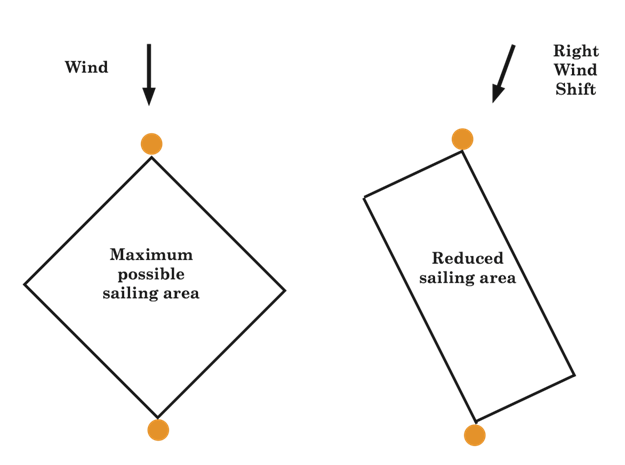
Assuming an upwind tacking angle of 90°…
SHIFT
5°
10°
20°
30°
45°TIME ON
FAVORED TACK
54%
59%
68%
79%
100%EFFECTIVE
SAILING AREA
98%
94%
77%
50%
0%It gets even worse downwind…
Assuming a downwind gybing angle of 50°…
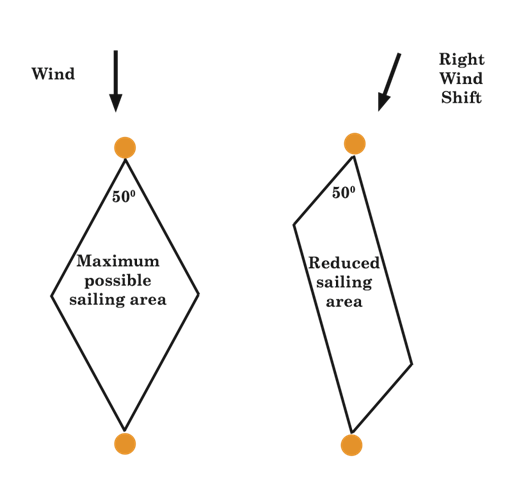
SHIFT
5°
10°
15°
20°
25°TIME ON
FAVORED TACK
59%
69%
79%
89%
100%EFFECTIVE
SAILING AREA
96%
83%
62%
35%
0%So… how is a change signaled?
“…
If the direction of the leg will be changed, the signal shall be the display of flag C with repetitive sounds and one or both of
the new compass bearing or
a green triangle for a change to starboard or a red rectangle for a change to port.“



“…


Let’s look at one of our courses at BLYC…

S – 1 – 2 – 3 – 1 – 3 – F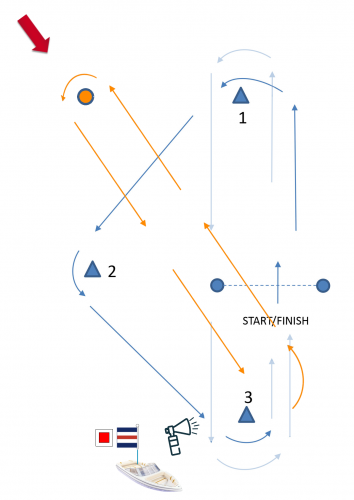
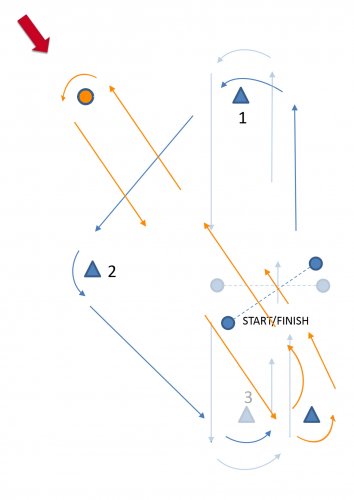
“…
How much of a shift will initiate a change?
It depends…
Is it ever required for the race committee to change course?
Next Week – Part 3 “Grab Bag”
… Rules 27, 31, 34, & 35
RRS – Part III; Post #7 – Rule 32 (con’t)
Rule 32 – Shortening or Abandoning After the Start
32.1
“After the starting signal, the race committee may shorten the course (display flag S with two sounds) or abandon the race (display flag N, N over H, or N over A, with three sounds)
In addition, the race committee may shorten the course so that other scheduled races can be sailed, or abandon the race because of an error in the starting procedure. However, after one boat has started, sailed the course and finished within the race time limit, if any, the race committee shall not abandon the race without considering the consequences for all boats in the race or series.”
32.2
“If the race committee signals a shortened course (displays flag S with two sounds), the finishing line shall be,
“In addition, the race committee may shorten the course so that other scheduled races can be sailed…”
What does it mean to “Shorten the Course?”
Let’s look again at one of our “typical” courses at BLYC…

How does the race committee shorten the course?
“… the race committee may shorten the course (display flag S with two sounds) …”

32.2
“If the race committee signals a shortened course (displays flag S with two sounds), the finishing line shall be,
“1. at a rounding mark, between the mark and a staff displaying flag S;

As shown above, this would be the ideal way the mark boat would set up the new line. It would be…
Again this is an area where the rules give the race committee a great deal of flexibility. Particularly if the course is being shortened for safety concerns, the race committee needs to be free to get things set up as quickly as possible. That may or may not be set up in an “ideal” configuration.
Note: It is perfectly acceptable and allowed under the rule for the mark boat to set up on the other side of the mark as shown below:
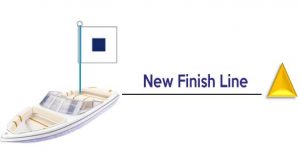
“3. at a gate, between the gate marks.”

2. “a line the course requires the boats to cross”
Next Week – Rule 33; Changing the Next Leg of the Course
